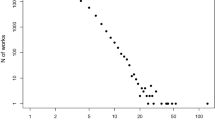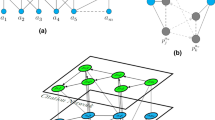Abstract











Similar content being viewed by others
Notes
Serbian Academy of Sciences and Arts.
The ComSIS Consortium is a group of leading scientific institutions from universities in Serbia including the Serbian Academy of Sciences and Arts, who jointly publish the ComSIS journal.
Due to our familiarity with the Serbian mathematics scene it was quite reasonable to assume that the majority of eLib authors are male.
The article "Serbian Virtual Observatory" published in "Review of the National Center for Digitization" in 2009 is the article with the highest number of authors per paper.
The last joint eLib paper of Ranko Bojanić and Miloš Tomić is dedicated to the memory of Slobodan Aljančić with whom they co-authored their first eLib paper.
The paper has title ”Une simple méthode pour obtenir la décomposition effective de Wold dans le cas des chaines de Markoff de corélations stationnaires“, and is published in ”Matematički Vesnik”.
References
Amaral, L. A. N., Scala, A., Barthélémy, M., & Stanley, H. E. (2000). Classes of small-world networks. Proceedings of the National Academy of Sciences of the USA, 97(21), 11,149–11,152.
Barabási, A. L., & Albert, R. (1999). Emergence of scaling in random networks. Science, 286(5439), 509–512.
Barabási, A. L., Jeong, H., Néda, Z., Ravasz, E., Schubert, A., & Vicsek, T. (2002). Evolution of the social network of scientific collaborations. Physica A, 311, 590–614.
Batagelj, V., & Mrvar, A. (2000). Some analyses of Erdős collaboration graph. Social Networks, 22(2), 173–186.
Bettencourt, L. M. A., Kaiser, D. I., & Kaur, J. (2009). Scientific discovery and topological transitions in collaboration networks. Journal of Informetrics, 3(3), 210–221.
Börner, K., Maru, J. T., & Goldstone, R. L. (2004). The simultaneous evolution of author and paper networks. Proceedings of the National Academy of Sciences of the USA, 101(Suppl 1), 5266–5273.
Brunson, J.C., Fassino, S., McInnes, A., Narayan, M., Richardson, B., Franck, C., Ion, P., & Laubenbacher, R. (2012). Evolutionary Events in a Mathematical Sciences Research Collaboration Network. arXiv:1203.5158.
Cunningham, S., & Dillon, S. (1997). Authorship patterns in information systems. Scientometrics, 39(1), 19–27.
de Solla Price, D. J. (1965). Networks of scientific papers. Science, 149(3683), 510–515.
Ding, Y., Foo, S., & Chowdhury, G. (1998). A bibliometric analysis of collaboration in the field of information retrieval. International Information and Library Review, 30(4), 367–376.
Dravec Braun, J. (2012). Effects of war on scientific production: Mathematics in Croatia from 1968 to 2008. Scientometrics, 93(3), 931–936.
Garfield, E., & Sher, I. H. (1963). New factors in the evaluation of scientific literature through citation indexing. American Documentation, 14(3), 195–201.
Girvan, M., & Newman, M. E. J. (2002). Community structure in social and biological networks. Proceedings of the National Academy of Sciences, 99(12), 7821–7826. doi:10.1073/pnas.122653799.
Gollapalli, S. D., Mitra, P., & Giles, C. L. (2011). Ranking authors in digital libraries. In Proceedings of the 11th annual international ACM/IEEE joint conference on Digital libraries (pp. 251–254) New York, NY, USA: ACM, JCDL ’11.
Grossman, J. (2002a). The evolution of the mathematical research collaboration graph. Congressus Numerantium, 158, 201–212.
Grossman, J. (2002b). Patterns of collaboration in mathematical research. SIAM News, 35(9), 8–9.
Grossman, J. W., & Ion, P. D. F. (1995). On a portion of the well known collaboration graph. Congressus Numerantium, 108, 129–131.
Hou, H., Kretschmer, H., & Liu, Z. (2008). The structure of scientific collaboration networks in Scientometrics. Scientometrics, 75(2), 189–202.
Ivanović, D., Surla, D., & Racković, M. (2012). Journal evaluation based on bibliometric indicators and the CERIF data model. Computer Science and Information Systems, 9(2), 791–811.
Kalmukov, Y. (2012). Describing papers and reviewers’ competences by taxonomy of keywords. Computer Science and Information Systems, 9(2), 763–789.
Liben-Nowell, D., & Kleinberg, J. (2003). The link prediction problem for social networks. In Proceedings of the Twelfth International Conference on Information and Knowledge Management (pp. 556–559) New York, NY, USA: ACM, CIKM ’03.
Lindsey, D. (1980). Production and citation measures in the sociology of science: The problem of multiple authorship. Social Studies of Science, 10(2), 145–162.
Liu, X., Bollen, J., Nelson, M. L., & Van de Sompel, H. (2005). Co-authorship networks in the digital library research community. Information Processing and Management, 41(6), 1462–1480.
Lotka, A. J. (1926). The frequency distribution of scientific production. Journal of Washington Academy of Science, 16, 317–323.
Mijajlović, Ž., Ognjanović, Z., & Pejović, A. (2010). Digitization of mathematical editions in Serbia. Mathematics in Computer Science, 3(3), 251–263.
Mimno, D., & McCallum, A. (2007). Mining a digital library for influential authors. In Proceedings of the 7th ACM/IEEE-CS joint conference on Digital libraries (pp. 105–106) New York, NY, USA: ACM JCDL ’07.
Nascimento, M. A., Sander, J., & Pound, J. (2003). Analysis of SIGMOD’s co-authorship graph. SIGMOD Record, 32(3), 8–10.
Newman, M. E. J. (2004a). Coauthorship networks and patterns of scientific collaboration. Proceedings of the National Academy of Sciences, 101(1), 5200–5205.
Newman, M. E. J. (2001a). Scientific collaboration networks I: Network construction and fundamental results. Physical Review E, 64(016), 131.
Newman, M. E. J. (2001b). Scientific collaboration networks II: Shortest paths, weighted networks, and centrality. Physical Review E, 64(016), 132.
Newman, M. E. J. (2004b). Who is the best connected scientist? A study of scientific coauthorship networks. In E. Ben-Naim, H. Frauenfelder, & Z. Toroczkai (Eds.), Complex networks (Vol. 650, pp. 337–370). Lecture Notes in Physics Berlin Heidelberg: Springer.
Newman, M. E. J. (2005). Power laws, Pareto distributions and Zipf’s law. Contemporary Physics, 46(5), 323–351.
Pao, M. L. (1986). An empirical examination of Lotka’s law. Journal of the American Society for Information Science, 37(1), 26–33.
Perc, M. (2010). Growth and structure of Slovenia’s scientific collaboration network. Journal of Informetrics, 4(4), 475–482.
Rodriguez, M.A., Bollen, J. (2008). An algorithm to determine peer-reviewers. In Proceedings of the 17th ACM Conference on Information and Knowledge Management (pp. 319–328) New York, NY, USA: ACM, CIKM ’08.
Voos, H. (1974). Lotka and information science. Journal of the American Society for Information Science, 25(4), 270–272.
Watts, D. J., & Strogatz, S. H. (1998). Collective dynamics of ‘small-world’ networks. Nature, 393(6684), 440–442.
Acknowledgments
Miloš Savić, Mirjana Ivanović and Miloš Radovanović gratefully acknowledge the support of this work by the Serbian Ministry of Education, Science and Technological Development through project Intelligent techniques and their integration into wide-spectrum decision support, No. OI174023. Zoran Ognjanović, Aleksandar Pejović and Tatjana Jakšić Krüger gratefully acknowledge the support of this work by the Serbian Ministry of Education, Science and Technological Development through project Development of new information and communication technologies, based on advanced mathematical methods, with applications in medicine, telecommunications, power systems, protection of national heritage and education, No. III44006.
Author information
Authors and Affiliations
Corresponding author
Rights and permissions
About this article
Cite this article
Savić, M., Ivanović, M., Radovanović, M. et al. The structure and evolution of scientific collaboration in Serbian mathematical journals. Scientometrics 101, 1805–1830 (2014). https://doi.org/10.1007/s11192-014-1295-6
Received:
Published:
Issue Date:
DOI: https://doi.org/10.1007/s11192-014-1295-6
Keywords
- Digital library
- Serbian mathematical journals
- Co-authorship network
- Connected components
- Evolutionary trends
- Collaborative behaviour
- Author metrics




